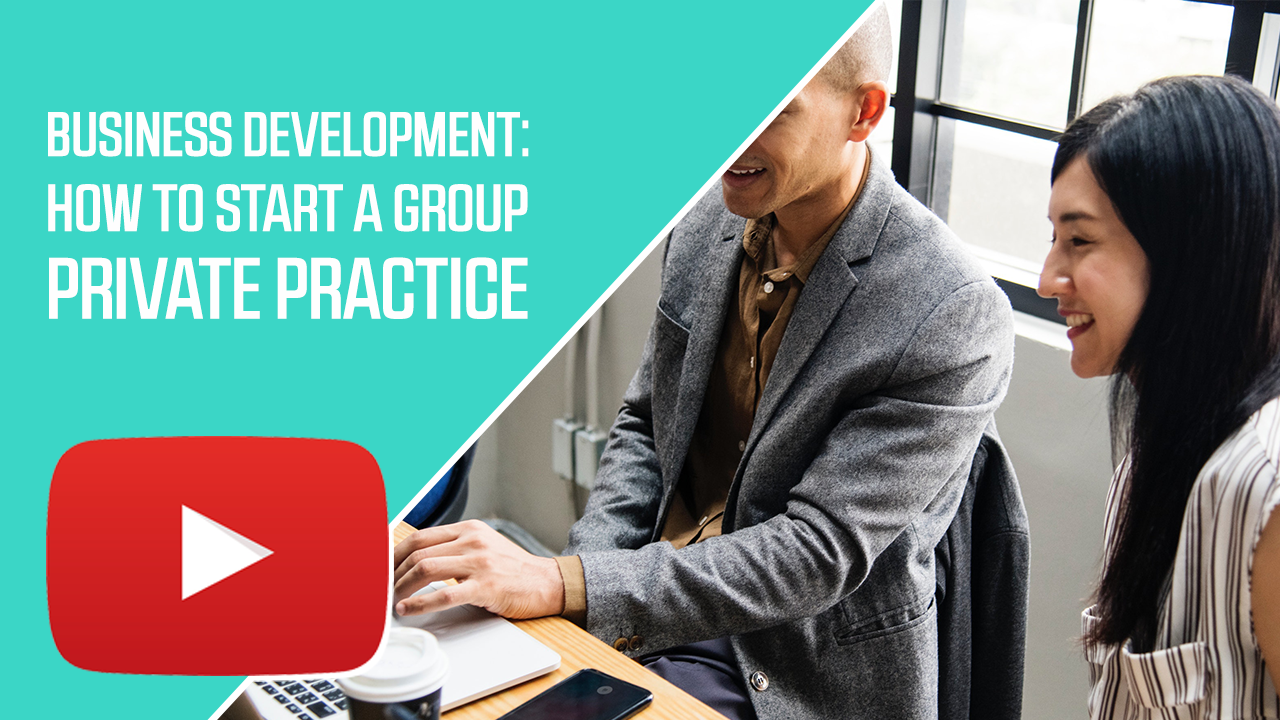Today I am addressing a few questions I often receive about starting a group private practice.
Percentage Split Within A Group Practice
On-boarding Phase
When new clinicians are in the on-boarding phase it is a 50-50 split for everything. Until they have their first month where they bring in $2,500. After this they will move into full clinician phase.
Clinician Phase
This resets on the first of the month and it’s only money that’s collected. I don’t want to be paying someone for something on the hypothesis that they’re going to get paid. They’re most motivated to collect that money before they have the money. After they get paid they’re not as motivated.
Here’s the formula:
- First $1,000 (this is for everybody, whether they’ve been with me for seven years or they’ve just started and moved out of that on-boarding phase) is a 50/50 split.
- Right away this is $500 per person and this is going to cover my basic rent, basic infrastructure, phones, internet, website etc.
- For the next $1500 it’s a 65/35 split. This means that if someone turns in $900 in their first week, they’re get half of that = $450.
- The next week if they turn in $500, that first $100 is going to be 50/50 = $50 for them. Then that next $400 will be 65%, so that would approximately be $270 in addition to the $50.
- The next phase is $2,500 and at that point it switches to a 75/25 split. This works for my market and my margins as well as for the amount of time that goes into my staff.
Things I Spend My Time On
- Hand writing checks each week
- Once a month I’m on local radio
- I write an article for the newspaper once a month to talk about the practice
These are things that I would be doing anyway, whether I had a group practice or an individual practice. So really the only time that I spend is that on-boarding period, writing of the checks and keep things going.
So Why Is This Not Fee Splitting
In the ACA code of ethics it states that you can’t do fee splitting, and a lot of people have read what I just described as fee splitting. If you read around those ethics, it’s basically means that if you send a client to someone else and they then give you a kickback. Kickback and fee splitting are all legal terms that mean that you’re getting an affiliate commission. So if I refer you to Bluehost or Practice Solutions, I get money for that. That’s fine if you disclose it and if you’re honest about it.
You don’t want this to be the case when you’re doing your clinical work. You don’t want to have a certain attorney send people to you and then you get a $100 from that attorney. If you’re referring out of your practice, lets say you don’t do play therapy and someone gave you a split of that fee, that wouldn’t be considered ethical either.
The rationale for why people are all up in arms about what I just described is because they believe that if you know you’re getting a percentage of what they bring in, you’re more likely to refer to them than you are to somebody else – so they should be W2 employees. That doesn’t take away the fact that what you just explained, you’re more likely to refer internally, this is not going to go away. So if someone’s a W2 employee where I have the liability to pay for that person, yes I’m probably going to refer to them anyway. It doesn’t take away the fact of what it is and also in the legal description the way it’s described is in regards to sending people out and getting kickbacks.
Why Should You Start A Group Practice Even When You’re Not Busy?
A lot of times people think ‘Well I need to have X number of clients before I bring people in’. If you bring in someone who compliments your services and doesn’t compete with your service (compliment vs. compete) it can actually keep more money internally. So for example say you’re a couples counselor you do couples work, but you don’t like working with kids. Instead you bring in a clinician who works after school, two nights a week. Maybe they have a full time job and can work through their lunch so that they can be there a couple of nights a week and they only help kids. That then keeps more of those services internal, it’s time that you weren’t using the office anyway, maybe it’s on a Saturday or Sunday and you’re off with your family.
Expand Your Network
By adding clinicians that compliment you when you’re starting out is really important because those people have a bubble of influence that is different to what you have. They may be members of the Yacht Club, Country Club or Rotary, they might go to a different school. They might have their kids in public school while you have kids in private school or vice-versa. They’re going to be connected to people that you’re not connected with.
The Numbers
- If we had someone that came in 2 nights a week and they needed 3 sessions = 6 sessions
- Someone else came in on a Saturday and did 4 sessions = 10 sessions a week
- If they’re charging $115 (you charge $135, you want it to be just a little bit lower than you charge) = $1150 per week (gross)
- Now we’re going to multiply that time by 48 weeks = $55,200 per year (gross)
- If you take 35% of that it ends up being about $19,000 extra for you
If you want to make these numbers work maybe you need to raise their rates or they need to do a few more sessions. Should you want to take home $50,000 (that would need to be 35% of a $140,000) you will then divide that over 48 weeks. This will be almost $3,000 that those people would need to bring in. Now let’s say we’re going to have 20 sessions, that means they need to charge $148 per session. So if you have those numbers then you can say ‘oh that doesn’t work for my my neighborhood’ or ‘that doesn’t work for my city’.
- They then need to do more sessions
- You need a second office
- You need to have more counselors that are working
That’s where the numbers can start to work out and inform you based on the number of:
- Sessions
- Weeks they work
- Clinicians
- Price
Each office can often times house 1 to 2 full-time people and 1 part-time person, so if you have a single office suite you can do about 20 to 25 sessions. This would be considered full-time – someone else can do that and then you can have a part-time person on top of it without ever upgrading your space.
Joseph R. Sanok, MA, LLP, LPC, NCC
 Joe Sanok is an ambitious results expert. He is a private practice business consultant and counselor that helps small businesses and counselors in private practice to increase revenue and have more fun! He helps owners with website design, vision, growth, and using their time to create income through being a private practice consultant. Joe was frustrated with his lack of business and marketing skills when he left graduate school. He loved helping people through counseling, but felt that often people couldn’t find him. Over the past few years he has grown his skills, income, and ability to lead others, while still maintaining an active private practice in Traverse City, MI.:
Joe Sanok is an ambitious results expert. He is a private practice business consultant and counselor that helps small businesses and counselors in private practice to increase revenue and have more fun! He helps owners with website design, vision, growth, and using their time to create income through being a private practice consultant. Joe was frustrated with his lack of business and marketing skills when he left graduate school. He loved helping people through counseling, but felt that often people couldn’t find him. Over the past few years he has grown his skills, income, and ability to lead others, while still maintaining an active private practice in Traverse City, MI.:

